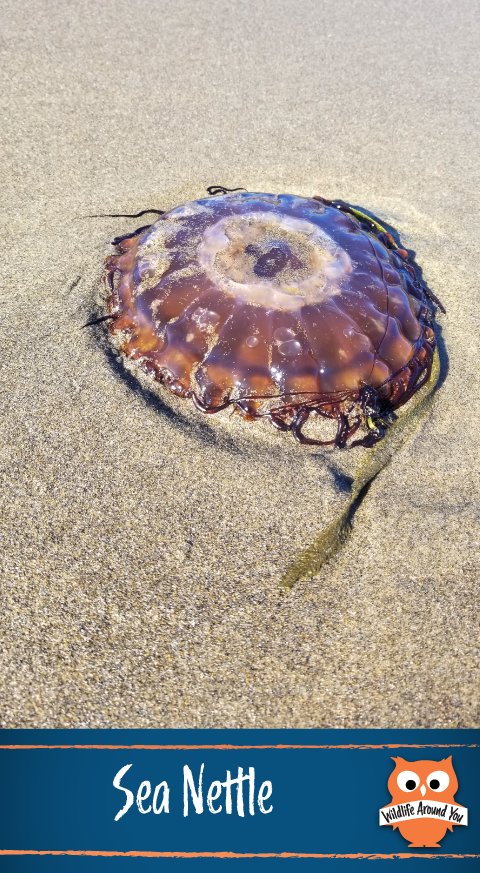Identification
West Coast- Golden brown bell(or medusa) with a reddish tint. Can grow to be more than three feet across in the wild. It has white arms and 24 maroon tentacles that trail behind it. Up to 15ft in length.
East Coast- Four thick, long, lacy oral arms hang from the bell margin, which is scalloped into shallow lobe-like structures called lappets. There are 4 to 40 long thread-like tentacles on the bell margin that alternate with marginal sense lobes (rhopalia) between lobes. Pink nettles usually have 10 tentacles and white ones have 21. The jellies found in Chesapeake Bay’s middle bay and estuaries have a bell diameter of about 10 cm (4 in) and a height of 5 cm (2 in). Open ocean and outer bay jellies may have bell diameters of 13 to 25 cm (5 to 8 in) and heights of 13 to 19 cm (5 to 7 in).
Habitat
There are west coast and east coast Sea Nettles.
West coast range from California to Oregon primarily, but some go as far north as the Gulf of Alaska.
Pacific sea nettles live near the surface of the water column in shallow bays and harbors in the fall and winter. In spring and summer, they often form large swarms in deep ocean waters.
East Coast or Atlantic are located from Cape Cod south along the U.S. East Coast, Caribbean, and Gulf of Mexico. Larger numbers in the Chesapeake Bay
Behavior
Swim by squeezing the bell together to push water behind them. Usually, they just float.
Offspring
Females will catch sperm released by males to fertilize the eggs she has produced and is holding in her mouth. The fertilized eggs stay attached to her oral arms and begin to grow. Once they have grown into flower-shaped polyps they are released into the ocean where they attach to solid surfaces to undergo asexual reproduction. The polyp makes identical copies of itself by”budding” a new polyp from its side. After the new polyp is fully formed, it too is released into the ocean undergoing metamorphosis and developing a bell, arms, and tentacles until it is fully formed.
Predators
Many marine birds and large fish feed on them in spite of their potent sting. Sea turtles, tuna, sunfish, etc.
Diet
They are carnivores and catch their prey using their tentacles to paralyze their prey with a toxin. The trailing tentacles retract and transport the food up the tentacle to the gastric cavity where digestion occurs. Large prey is partially digested on the oral arms before being transported to the gastrovascular cavity. Once the prey has been transferred, the tentacles extend again to become fishing lines once more.
They eat zooplankton, crustaceans, snails, small fish, and other jellyfish.
Usually, the toxin is not fatal to humans. Pain caused by the sting of a Pacific sea nettle is similar in intensity to that of a bee sting. It does not have serious effects except in those individuals who are sensitive to the toxin.
Fun Facts
Sea nettles do not see images but are able to differentiate between light and dark using small pigmented structures on the bell or tentacle base called “eye spots” or ocelli. They maintain their balance and orientation to the ocean bottom and surface with statocysts, vesicles that contain mineral salts that stimulate sensory cells in response to the jelly’s movement
The genus name of sea nettle jellies, Chrysaora, comes from Greek mythology. Chrysaor, reportedly a giant, was the son of Poseidon and Medusa. His name translates as ‘golden falchion’. A falchion was a commonly used curved fighting sword that could cut through armor, a reference to the stinging ability of these jellies. The West Coast sea nettle’s species name, fuscescens, means dusky or dark referring to the dusky color of the nettle’s bell.
Some jellies commute 3,600 feet (1,097 m) up and down in the water daily
We’ve all heard the age-old rumor that urinating on a sea jelly sting will help heal the effects or at least relieve pain. According to the American Chemical Society, though, you’re better off rinsing the affected area in sea jelly-free saltwater instead. The sting is caused by nematocysts on the sea nettle’s tentacles, and rinsing will help remove any remaining tentacles and excess nematocysts.

